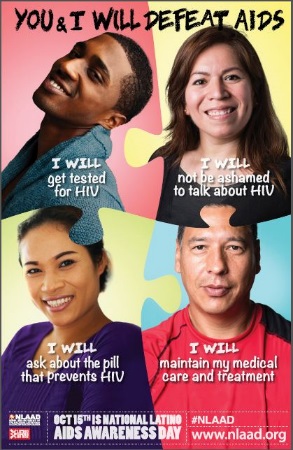LatinaLista — October 15 is a day with multiple observances: Breast Health Day, Conflict Resoultion Day, Global Handwashing Day, National White Cane Day and it's even I Love Lucy Day. However, October 15 may best be known in the Latino community as National Latino AIDS Awareness Day (NLAAD).
The AIDS epidemic among Latinos has evolved to the point that today most new diagnoses occur among Latino gay and bisexual men (81%). The disturbing fact, as revealed by studies by the Centers for Disease Control & Prevention (CDC), is that:
An estimated 43% of Hispanics or Latinos who received an HIV diagnosis were not born in the United States or Puerto Rico (a U.S. territory), and among these Hispanic or Latino immigrants, 66% were men who have sex with men.
As a result, there are more than 220,000 Latinos living with HIV/Aids. The CDC finds that Latinos account for 22 percent of new HIV infections and contract HIV, at more than three times the rate of non-Latino whites, making HIV/AIDS the seventh-largest killer of Latinos among those aged 25 to 34 in the United States.
Cultural stigma continues to play a huge part in keeping Latinos and Latinas from receiving available testing and not talking about it with friends, family members or even healthcare workers, which just makes a bad situation potentially worse.
To combat the silence that surrounds the topic, this year NLAAD has two ongoing themes: YOU & I Will Defeat AIDS, along with the CDC's campaign, We Can Stop HIV One Conversation at a Time.
Both campaigns strive to underscore that AIDS/HIV is a community issue that need not be suffered in lonely silence anymore. It's an issue that as a community we should be encouraging:
- That everyone gets tested for it.
- People at-risk for contracting HIV/AIDS should use condoms responsibly when having sex
- Caution against having multiple sexual partners
- And get tested and treated for other sexually trasmitted diseases
While there may not be a cure, there is treatment for AIDS/HIV that can ensure a much better quality of life and outcome for a diagnosis that used to be seen as an inevitable death sentence.



